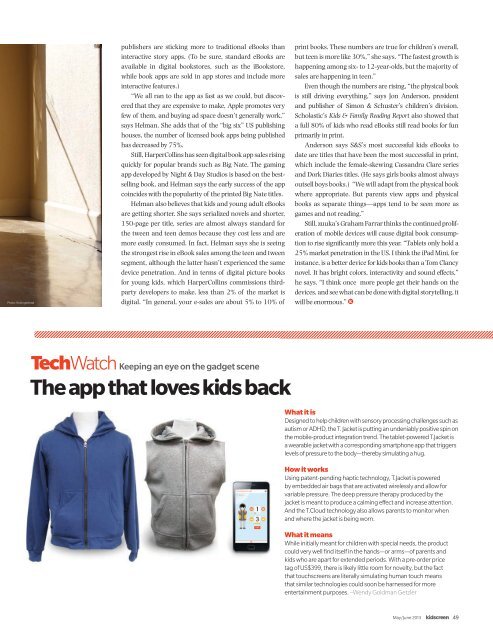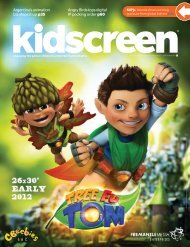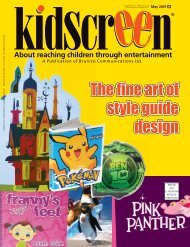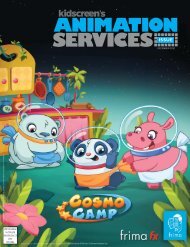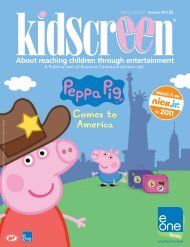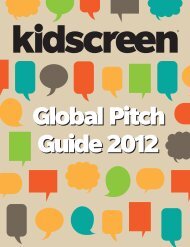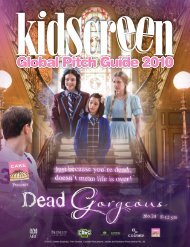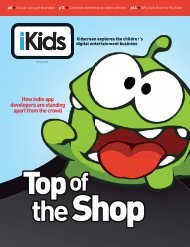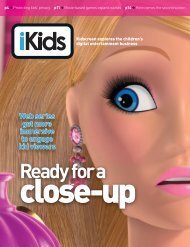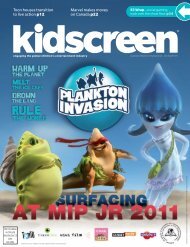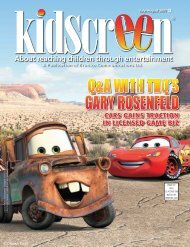download a PDF version - Kidscreen
download a PDF version - Kidscreen
download a PDF version - Kidscreen
You also want an ePaper? Increase the reach of your titles
YUMPU automatically turns print PDFs into web optimized ePapers that Google loves.
Photo: flickingerbrad<br />
publishers are sticking more to traditional eBooks than<br />
interactive story apps. (To be sure, standard eBooks are<br />
available in digital bookstores, such as the iBookstore,<br />
while book apps are sold in app stores and include more<br />
interactive features.)<br />
“We all ran to the app as fast as we could, but discovered<br />
that they are expensive to make, Apple promotes very<br />
few of them, and buying ad space doesn’t generally work,”<br />
says Helman. She adds that of the “big six” US publishing<br />
houses, the number of licensed book apps being published<br />
has decreased by 75%.<br />
Still, HarperCollins has seen digital book app sales rising<br />
quickly for popular brands such as Big Nate. The gaming<br />
app developed by Night & Day Studios is based on the bestselling<br />
book, and Helman says the early success of the app<br />
coincides with the popularity of the printed Big Nate titles.<br />
Helman also believes that kids and young adult eBooks<br />
are getting shorter. She says serialized novels and shorter,<br />
150-page per title, series are almost always standard for<br />
the tween and teen demos because they cost less and are<br />
more easily consumed. In fact, Helman says she is seeing<br />
the strongest rise in eBook sales among the teen and tween<br />
segment, although the latter hasn’t experienced the same<br />
device penetration. And in terms of digital picture books<br />
for young kids, which HarperCollins commissions thirdparty<br />
developers to make, less than 2% of the market is<br />
digital. “In general, your e-sales are about 5% to 10% of<br />
print books. These numbers are true for children’s overall,<br />
but teen is more like 30%,” she says. “The fastest growth is<br />
happening among six- to 12-year-olds, but the majority of<br />
sales are happening in teen.”<br />
Even though the numbers are rising, “the physical book<br />
is still driving everything,” says Jon Anderson, president<br />
and publisher of Simon & Schuster’s children’s division.<br />
Scholastic’s Kids & Family Reading Report also showed that<br />
a full 80% of kids who read eBooks still read books for fun<br />
primarily in print.<br />
Anderson says S&S’s most successful kids eBooks to<br />
date are titles that have been the most successful in print,<br />
which include the female-skewing Cassandra Clare series<br />
and Dork Diaries titles. (He says girls books almost always<br />
outsell boys books.) “We will adapt from the physical book<br />
where appropriate. But parents view apps and physical<br />
books as separate things—apps tend to be seen more as<br />
games and not reading.”<br />
Still, zuuka’s Graham Farrar thinks the continued proliferation<br />
of mobile devices will cause digital book consumption<br />
to rise significantly more this year. “Tablets only hold a<br />
25% market penetration in the US. I think the iPad Mini, for<br />
instance, is a better device for kids books than a Tom Clancy<br />
novel. It has bright colors, interactivity and sound effects,”<br />
he says. “I think once more people get their hands on the<br />
devices, and see what can be done with digital storytelling, it<br />
will be enormous.”<br />
TechWatch Keeping an eye on the gadget scene<br />
The app that loves kids back<br />
What it is<br />
Designed to help children with sensory processing challenges such as<br />
autism or ADHD, the T. Jacket is putting an undeniably positive spin on<br />
the mobile-product integration trend. The tablet-powered T.Jacket is<br />
a wearable jacket with a corresponding smartphone app that triggers<br />
levels of pressure to the body—thereby simulating a hug.<br />
How it works<br />
Using patent-pending haptic technology, T.Jacket is powered<br />
by embedded air bags that are activated wirelessly and allow for<br />
variable pressure. The deep pressure therapy produced by the<br />
jacket is meant to produce a calming effect and increase attention.<br />
And the T.Cloud technology also allows parents to monitor when<br />
and where the jacket is being worn.<br />
What it means<br />
While initially meant for children with special needs, the product<br />
could very well find itself in the hands—or arms—of parents and<br />
kids who are apart for extended periods. With a pre-order price<br />
tag of US$399, there is likely little room for novelty, but the fact<br />
that touchscreens are literally simulating human touch means<br />
that similar technologies could soon be harnessed for more<br />
entertainment purposes. –Wendy Goldman Getzler<br />
May/June 2013<br />
49


